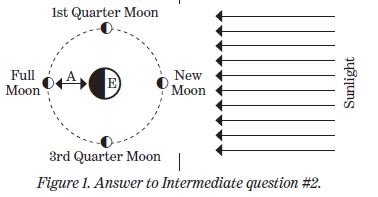look on an extremely dark night (and have excellent eyesight), you might spot Uranus.
2. b. As light passes through inhomogeneities in the atmosphere, it gets bounced around, blurring images viewed through ground–based telescopes. HST, a 2.4– meter telescope, collects less light than larger (up to 10-meter), ground-based telescopes. However, because HST orbits above the atmosphere, it obtains much clearer images.
3. c. Seasons are caused by the tilt of Earth's axis. Summer is warmer because the Sun is above the horizon for a longer time and the sunlight is more direct, since the Sun is higher in the sky. Winter is cooler because days are shorter and the Sun is lower in the sky. If Earth had no axial tilt, we would not experience any seasonal variations!
4. True. More than 4,000 extrasolar planets have been confirmed, primarily by observing the gravitational influence that they exert on their parent stars and by the transit method. NASA's Kepler Space Telescope alone confirmed the existence of more than 2,000 via the transit method: It watched for the slight drops in stellar brightness that occur when planets cross between Earth and their parent stars. 5. True. It is believed that nearly 4 billion years ago, Mars was warmer and had a thicker atmosphere, allowing for liquid water to exist on its surface. Today, the surface shows now-dry valleys and channels that appear to have been carved by flowing water.

6. False. While Mars might have once been hospitable to life, no conclusive evidence exists to prove that life existed on Mars at any time.
Intermediate 1. c. Galileo was the first to use the telescope to systematically observe the night sky. His observations of moons orbiting Jupiter and the phases of Venus lent crucial support to the Copernican Revolution. (Copernicus first developed and published a "heliocentric" model of the solar system, which put the Sun, not Earth, at its center.) Galileo spent the last decade of his life under house arrest as a suspected heretic for supporting the heliocentric model.
2. c. To see a "new" Earth from the Moon, Earth must be directly between the Moon and the Sun. In that case, people on Earth would see a full Moon. See "A" view in Figure 1. (continued)